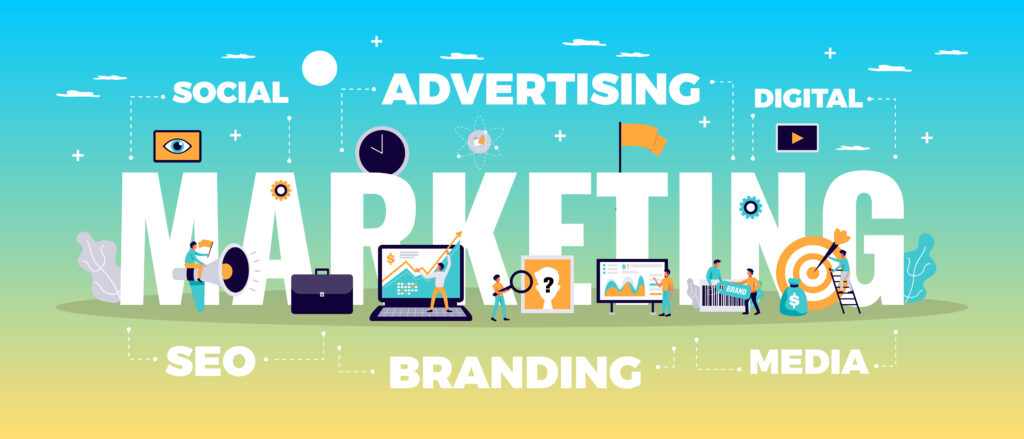Ahead Of The Curve Exploring The Future Of Social Media Marketing In The Uk
Are you prepared to stay on top of developments in the rapidly changing field of social media marketing? Over time, there has been a significant change in the environment. It’s important to follow the most recent trends if you work in marketing in the UK.
Consumers no longer rely entirely on traditional search engines to find information; instead, they now look to social media. However, being active on these sites is no longer enough. Understanding how consumer preferences are evolving will help you adjust your approach.
One significant change we’re observing is a shift toward micro-influencers. The days of only using celebrities to advertise your brand are long gone. Instead, advertisers are making use of the influence of regular individuals who have smaller, more specialized followings. These micro-influencers have a sincere connection with their audience, which increases the credibility and influence of their suggestions and endorsements.
You may connect with your target audience more genuinely and increase engagement and conversion rates by working with the appropriate micro-influencers. Don’t undervalue the influence these social media users have because they can hold the secret to your brand’s success.
Key Takeaways
- Social media has surpassed traditional search engines as consumers’ go-to platform for information.
- Consumers increasingly use micro-influencers in marketing initiatives because they believe they can help them find the right products.
- On social media sites, chatbots are already being utilized for customer care, and this trend is projected to continue.
- Customers prefer visual material, which has led to the growth of sites like TikTok and Instagram for search and discovery.
Current Social Media Landscape
Marketers are struggling to stay up with the shifting trends and consumer behavior as the social media landscape quickly changes. Consumer behavior has been dramatically changed by social media, with more individuals now using sites like Instagram and TikTok instead of conventional search engines to find information and products. Brands have been compelled by this change to modify their marketing plans in order to reach consumers where they are.
The increase of user-generated content is one of the major trends in the social media landscape today. Consumers today participate actively in the creation and sharing of content rather than just being passive viewers. Brands now have more chances to interact with their customers and use the authority of user-generated content to increase credibility. Brands can use the social proof effect to sway potential customers by encouraging them to share their opinions and experiences with a product or service.
Strategies for social media advertising have also changed as a result of the shifting environment. Targeted social media ads are becoming more popular as traditional advertising strategies like banner ads lose their effectiveness. Brands can reach their desired audience based on demographics, hobbies, and habits with comprehensive targeting choices. This makes it possible for advertising to be more personalized and pertinent, which boosts engagement and conversion rates.
The significance of social media analytics cannot be overemphasised in this changing environment. In order to comprehend their target market, gauge the effectiveness of their initiatives, and pinpoint areas for development, marketers must constantly monitor and analyze data. Brands may learn a lot about consumer behavior, content performance, and campaign efficacy by utilizing analytics technologies. This data-driven strategy enables marketers to make wise choices and maximize the effect of their social media efforts.
In the present social media environment, influencer marketing has also demonstrated its efficacy. For product research and suggestions, consumers trust influencers and creators. Working with influencers enables brands to capitalize on their devoted fan base and use their influence to market goods or services. However, it’s crucial for marketers to pick influencers carefully who share their brand’s values and have an interested and pertinent audience.
To stay on top of the continuously changing social media landscape, marketers must constantly modify their approaches and adopt new trends. Brands can successfully navigate this dynamic landscape and meaningfully connect with their audience by understanding the impact of social media on consumer behavior, leveraging user-generated content, implementing targeted advertising strategies, utilizing social media analytics, and utilizing influencer marketing.
Find out how Juvios Digital Marketing Solutions can help your business grow.
Shift towards Micro-Influencers
Marketers in the UK are observing a move toward micro-influencers as social media develops because they have the ability to solidify hypotheses and forge powerful images in consumers’ minds. These influencers have emerged as the go-to source for authenticity in the internet sphere thanks to their modest but very active followings. They have mastered the art of niche marketing by focusing on particular groups and providing their audience with material that has a strong emotional connection.
Brands may access these groups and establish a more intimate connection with consumers by working with micro-influencers. Working with micro-influencers has a number of benefits, one of which is the potential for long-term alliances. Micro-influencers are more likely to commit to long-term brand connections than celebrities, who occasionally work on transient projects. This enables regular exposure and messaging, fostering familiarity and trust among the audience. As the influencer develops into a dependable brand supporter, marketers can foster a sense of authenticity and loyalty by fostering these ties.
To effectively use micro-influencers and promote meaningful connections between the influencer and their audience, marketers must establish engagement methods. This might be done by holding giveaways, doing Q&A sessions, or working together to create interactive material. By building these relationships, marketers can engage influencers’ engaged following and engage customers in a real conversation.
Marketers need to look beyond conventional measures like reach and impressions when evaluating the success of micro-influencer initiatives. Instead, they ought to concentrate on metrics like comments, shares, and direct messages that show actual interaction and conversions. Marketers may acquire insightful information about the success of their campaigns and make data-driven decisions for upcoming collaborations by examining these indicators.
Micro-influencers will undoubtedly be essential in determining how marketing in the UK will develop in the future as social media continues to develop. Brands can develop effective campaigns that connect with customers on a deeper level by leveraging their authenticity, specialized knowledge, and capacity to generate meaningful connections. Marketers will be able to gauge the effectiveness of their influencer marketing initiatives through these long-term collaborations and strategic engagement tactics.
Emergence of Chatbots
Marketers can improve customer service on social media platforms and transform how customers engage with businesses with the rise of chatbots. Numerous advantages of chatbots include their 24/7 accessibility, quick responses, and capacity to manage multiple customer concerns at once. Chatbots allow businesses to instantly assist clients, enhancing their overall experience and raising customer happiness.
Additionally, chatbots can gather useful customer choice and behavior information, allowing marketers to customize their marketing campaigns and deliver relevant content.
With the incorporation of chatbots, there are substantial ramifications for customer service. Now that repetitive and boring jobs can be automated, human agents are free to concentrate on more complicated consumer enquiries. This helps organizations save money while simultaneously increasing efficiency. Additionally, chatbots can deliver precise and consistent responses, guaranteeing that consumers always get the same level of care. Additionally, chatbots can respond to questions from customers via direct messaging on social media platforms, enabling businesses to interact with consumers in a more convenient and approachable way.
In order for chatbots to function properly, AI is essential. Artificial intelligence-powered chatbots can comprehend natural language and context, enabling more human-like interactions with clients. Their replies and problem-solving skills can be continuously improved by their ability to learn from and adapt based on client interactions. Chatbots can evaluate client data and provide data-driven recommendations thanks to AI, which improves the customer experience. However, deploying chatbots can be difficult since it requires making sure that responses are correct and pertinent, preventing misunderstandings, and striking a balance between automation and human engagement. To properly solve these issues, marketers must carefully create and train chatbots.
Chatbots have a lot of potential for social media marketing in the future. Chatbots will become more smart as technology develops and be able to handle even difficult client enquiries. They’ll play a crucial role in the integration of online shopping experiences on social media platforms, offering customized product recommendations and facilitating smooth transactions. Chatbots will be crucial for lead generation and customer engagement as messaging apps gain in popularity. Additionally, chatbots can be combined with other AI tools, like voice assistants, to offer a smooth and customized consumer experience across a variety of platforms.
In general, chatbots have the potential to transform social media marketing by allowing businesses to offer their customers quick, individualized service that is easy to reach.
Visual-Forward Content Preference
In the frantic march of digital transformation, social media has transformed into a dazzling rainbow where marketers are fusing together enthralling visual tales to draw in and enrapture their audience.
Due of its unique search features, one site in particular has had an impact on consumer behavior: TikTok. With the addition of new search features, TikTok has established itself as a platform for top-tier products and content discovery. Consumers prefer visual-forward information for exploration, especially young adults. They have been able to quickly discover and explore new brands, goods, and trends thanks to TikTok’s search functionality. As more users turn to TikTok for their discovery requirements, this shift in consumer behavior puts established search engines like Google Maps and Google Search in danger.
Another visually-focused medium like Instagram is crucial for promoting brand awareness. Instagram has successfully converted itself into a shopping destination with its seamless integration of shopping elements. Now, customers can find things and buy them without ever leaving the app. By producing visually appealing material that presents their products in an engaging and aspirational way, brands are leveraging this trend. Brands may successfully pique the interest of their target audience by curating a visually appealing feed and making use of features like shoppable posts and stories, which will ultimately lead to sales.
Consumers are more likely to trust influencers than superstars when it comes to trust. Influencers’ opinions have more weight in the eyes of customers since they are perceived as more relatable and genuine. Numerous social media users prefer to find new products through the influencers they follow, according to studies. In fact, a lot of customers have made decisions based on recommendations from influencers. Due to a change in consumer trust, more firms are choosing to partner with micro-influencers, who have a smaller following but a more engaged and devoted audience. Brands may efficiently contact and connect with their target consumers by utilizing the authority and trust of these micro-influencers.
The promise of AI chatbots in customer care cannot be overlooked as social media’s future develops. In the upcoming years, chatbots are anticipated to overtake humans as the main method of customer care for many firms. Chatbots give businesses an easy and effective way to interact with their customers since they can give quick, customised responses. They can respond to DMs on social media platforms and other types of client questions. The use of chatbots in customer care raises customer satisfaction while saving businesses important time and resources.
Visual-forward content, influencer recommendations, and the seamless integration of shopping functionalities will likely continue to be the driving forces behind product discovery on social networking platforms in the future. Brands with a competitive edge in attracting the interest and allegiance of their target audience are those who adopt and embrace these trends.
Find out how Juvios Digital Marketing Solutions can help your business grow.
Integrated Shopping Experiences
The seamless integration of purchasing experiences will be the key to brand discovery on social media in the future. Consumers no longer read endlessly through product lists on e-commerce platforms. Instead, when they anticipate finding and buying things directly through their preferred social media sites. This change is being brought about by the rapid expansion of mobile commerce, as more and more people turn to their cellphones for online purchasing.
Social media platforms may be used by brands to take advantage of this trend and give customers a convenient and engaging purchasing experience by integrating shopping functionality.
- Mobile commerce growth: The popularity of smartphones has completely changed how people purchase. Consumers are increasingly using their cellphones for online shopping thanks to the convenience of mobile browsing and buying. Brands may take advantage of this expanding market by incorporating shopping experiences into social media platforms and connecting with customers where they spend the majority of their time.
- Social media advertising effectiveness: Social media networks offer businesses a unique opportunity to engage with their target audience through advertising that is both highly targeted and customized. By allowing customers to browse and purchase things right from the advertisements, marketers can improve the effectiveness of their advertising efforts. The effectiveness of social media advertising is increased, and there is a greater chance that consumers will convert to customers thanks to this seamless integration.
- Influencer marketing ROI: Influencer marketing has been quite successful at raising brand awareness and sales. Brands can leverage influencer marketing more effectively by integrating shopping into social media platforms. Influencer marketing campaigns that feature products and direct links for followers to use to make purchases yield higher returns on investment.
Brands can design engaging and immersive shopping experiences for their customers by embracing the expansion of mobile commerce, harnessing the efficiency of social media advertising, and optimizing the return on investment of influencer marketing. Social media integration of e-commerce platforms will meet consumer expectations and give firms a competitive edge in the rapidly changing social media landscape.
Frequently Asked Questions
How has the shift towards micro-influencers affected the effectiveness of social media marketing strategies?
TThe use of micro-influencers has completely changed social media marketing tactics. Their effectiveness is astounding, as seen by the extreme levels of consumer trust. Micro-influencer brand relationships have become a mainstay of modern marketing trends.
What are the key advantages of using chatbots for customer service on social media platforms?
There are many benefits to using chatbots for customer support on social media networks. They offer effectiveness, customisation, and automation, which reduces costs. They increase client satisfaction and reaction times by being accessible around-the-clock.
How has the preference for visual-forward content impacted how brands approach social media marketing?
The use of visual content has completely changed how firms use social media for marketing. In order to fascinate and engage consumers, influencer partnerships, user-generated content, video marketing, interactive commercials, and visual storytelling have become crucial methods.
How are chatbots expected to evolve in the future to enhance customer service on social media?
Prepare to be astounded by the development of chatbots! They will offer individualized interactions, improve automation effectiveness, and increase customer pleasure thanks to breakthroughs in AI. Prepare for a revolution in social media customer service!
Conclusion
Congratulations! You have successfully studied the prospects for social media advertising in the UK. You’re in a good position to take advantage of the changing environment and establish meaningful connections with your target audience if you stay one step ahead of the curve.
Thoughts like “But isn’t it risky to rely on micro-influencers instead of celebrities?” may be running through your head.It’s true that famous people have long been sought after for brand collaborations. But the move to micro-influencers is actually a calculated one. Though they may not have millions of fans, these influencers possess something even more valuable: honesty and relatability. You may reach niche communities and establish sincere relationships with your target audience by working with micro-influencers. Higher engagement, more trust, and better outcomes for your brand can result from this strategy.
The development of chatbots is another thing to think about. Using AI-powered bots on social media sites for customer support may raise some red flags for you. However, chatbots present a special chance to give quick and individualized customer care. They can respond to straightforward questions, freeing up your team to concentrate on trickier problems. Additionally, chatbots are accessible around-the-clock, ensuring that your consumers get help whenever they need it. You may improve the client experience and streamline your operations by utilizing this technology.
Finally, it is impossible to deny the inclination for visually stimulating information. Consumers are increasingly lured to visually appealing content, and platforms like TikTok and Instagram have emerged as go-to locations for product discovery. You can grab the attention of your target audience and differentiate yourself from the competition by utilizing these channels and producing aesthetically appealing content.
In conclusion, social media marketing in the UK has a promising and wide-open future. You can stay ahead of the curve and genuinely connect with your audience by embracing the move toward micro-influencers, utilizing AI-powered chatbots, and producing visually appealing content. So go ahead, investigate your options, and watch as your company prospers in the always changing social media landscape.
Find out how Juvios Digital Marketing Solutions can help your business grow.




